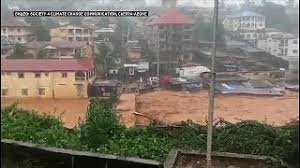By Hassan Osman Kargbo
As Sierra Leone transitions into its annual rainy season, concerns are mounting in Freetown, the nation’s capital, over the risk of devastating floods that have become all too familiar to its residents. With weather forecasts predicting heavier-than-usual rainfall this year, city dwellers and disaster management officials alike are bracing for what could be another challenging season marked by destruction and displacement.
Freetown experiences two distinct seasons: the dry season and the rainy season. While the dry months are not without their own challenges—such as recent fire outbreaks that have engulfed over 500 homes in the city, it’s the rainy season that poses the gravest threat to life and property in the city. Known for its dense population, poor drainage systems, and sprawling informal settlements, Freetown has often been described as one of West Africa’s most disaster-prone urban areas.
In past years, the city has witnessed floods that have claimed lives, destroyed homes, and left thousands displaced. The infamous August 14, 2017 landslide and flooding disaster, which killed over 1,000 people and left many more homeless, remains a painful memory that underscores the vulnerability of the capital during the rainy season.
As this year’s rains begin, there is a growing call for the government and its partners, especially the National Disaster Management Agency (NDMA), to take urgent and proactive measures to prevent a repeat of previous disasters.
Furthermore, weather experts have already issued early warnings indicating that this year’s rainy season would likely bring heavy downpours. Despite this, critics argue that not much has been done to prepare high-risk communities, particularly low-lying slum areas such as Kroo Bay, Susan’s Bay, and Moa Wharf—settlements that are notoriously prone to flooding.
“The warning signs are there. We’ve seen the forecasts. We know what happens every year. So the question is: what is being done to prevent loss of life and property?” asked Mariatu Bangura, a community leader in Kroo Bay community.
The NDMA has said it is working with local authorities and international partners to improve disaster preparedness and response. Efforts reportedly include clearing blocked drainage systems, conducting community sensitization campaigns, and identifying evacuation centers.
However, many residents remain skeptical, citing a history of slow response and inadequate infrastructure as major barriers to effective disaster management.
Also, Urban planning experts point to a number of systemic issues that contribute to Freetown’s vulnerability, including uncontrolled construction on hillsides, poor waste management that clogs drainage channels, and a lack of affordable housing, which forces many to settle in flood-prone areas.
Yusuf Koroma, an environmental engineer based in Freetown, says disaster risk in the city is not just a seasonal issue—it’s a long-term urban challenge. “Every year we talk about floods, and every year people die. It’s a cycle of disaster that won’t stop unless we address the root causes,” Koroma said. “We need proper housing, better drainage systems, and strict enforcement of building codes.”
In addition, Ironically, the dry season that just ended was also marked by disaster. Between January and March, more than 200 homes were destroyed in multiple fire outbreaks across Freetown’s informal settlements, incidents though different in nature, further highlight the precarious living conditions in the city’s underserved communities.
“These fires were devastating; but they also remind us how vulnerable we are, not just during the rains but all year round,” said Fatmata Sesay, a resident of Susan’s Bay whose home was recently destroyed by fire.
Sesay and her neighbors are now living in temporary shelters; and with the rains approaching, they fear being hit by a second wave of disaster.
Adamantly, community leaders, civil society organizations, and disaster experts are calling on the government to act decisively. They are urging for an integrated disaster management approach that combines early warning systems, community education, infrastructure development, and emergency response capacity.
International partners, including UN agencies and non-governmental organizations, are also being encouraged to support such efforts through funding, technical assistance, and policy advocacy.
“The time to act is now,” said an NDMA spokesperson in a press briefing earlier this week. “We are entering a critical period and we need all hands on deck to ensure that this rainy season does not become another tragic chapter in Freetown’s history.”
As clouds gather over the capital and the first signs of the rains begin to show, the question remains: Will this year be different? Only time will tell. But for the residents of Freetown, especially those in flood-prone areas, hope lies in the promise that authorities will heed the warnings and take swift, meaningful action before the waters rise once again.













